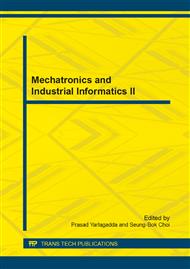[1]
Popat Miteshkumar, Wu Bin and Zargari Navid R: Fault ride-through capability of cascaded current-source converter-based offshore wind farm. IEEE Transactions on Sustainable Energy. 2013, 4(2): 314-323.
DOI: 10.1109/tste.2012.2223246
Google Scholar
[2]
Amr Ahmed A Radwan and Yasser Abdel-Rady I Mohamed: Analysis and Active Suppression of AC- and DC-Side Instabilities in Grid-Connected Current-Source Converter-Based Photovoltaic System. IEEE Transactions on Sustainable Energy. 2013, 4(3): 630-642.
DOI: 10.1109/tste.2012.2230653
Google Scholar
[3]
Harbouche Y, Khettache L and Abdessemed R: Sliding mode control application to the doubly fed asynchronous machine supplied by current sources. Advances in Modelling and Analysis C. 2009, 64(1-2): 15-26.
Google Scholar
[4]
Jing Bai, Shiqi Lu and Jian Liu. Study and Application of Sliding Mode Control Strategy for High-power Current Source Inverter. Applied Mechanics and Materials. 2014, 527: 259-266.
DOI: 10.4028/www.scientific.net/amm.527.259
Google Scholar
[5]
Xu Fei, Ma Hao and He Xiangning: A discrete-time variable rate reaching law controlled current-source inverter. Proceedings of the CSEE. 2007, 27(33): 98-102.
Google Scholar
[6]
Yu Yong: Discrete sliding mode control for current-source Inverter. Power Electronics. 2009, 43(1): 69-70.
Google Scholar
[7]
Zheng Xuesheng, Li Chunwen and Tang Honghai: Integral sliding mode control for three-phase PWM voltage source inverter. Transactions of china electrotechnical society. 2007, 22(12): 105-109.
DOI: 10.1109/chicc.2006.4347302
Google Scholar
[8]
Vadim, Utkin: Sliding mode control of DC/DC converters. Journal of the Franklin Institute. 2013, 350(8): 2146-2165.
DOI: 10.1016/j.jfranklin.2013.02.026
Google Scholar
[9]
Jiabing Hu, Shang Lei and He Yikang: Direct active and reactive power regulation of grid-connected DC/AC converters using sliding mode control approach. IEEE Transactions on Power Electronics. 2011, 26(1): 210-222.
DOI: 10.1109/tpel.2010.2057518
Google Scholar
[10]
Sosa, Jorge Luis: Sliding-Mode Input–Output Linearization Controller for the DC/DC ZVS CLL-T Resonant Converter. IEEE Transactions on Industrial Electronics. 2012, 59(3): 1554-1564.
DOI: 10.1109/tie.2011.2161253
Google Scholar
[11]
Adib Abrishamifar and Ahmad Ale Ahmad: Fixed Switching Frequency Sliding Mode Control for Single-Phase Unipolar Inverters. IEEE Transactions on Power Electronics. 2012, 27(5): 2507-2514.
DOI: 10.1109/tpel.2011.2175249
Google Scholar
[12]
Mallapu Gopinath Umamaheswari and Govindarajan Uma: Analysis and design of reduced-order sliding-mode controller for three-phase power factor correction using Cuk rectifiers. IET Power Electronics. 2013, 6(5): 935-945.
DOI: 10.1049/iet-pel.2012.0402
Google Scholar
[13]
Xiao Yanhong and Zhou Jinglin: The reaching law for variable structure control of discretetime system based on attenuating control. Control Theory and Applications. 2002, 19 (3): 450-452.
Google Scholar


